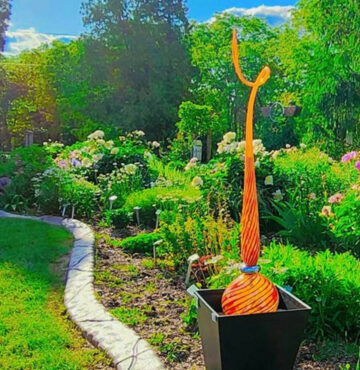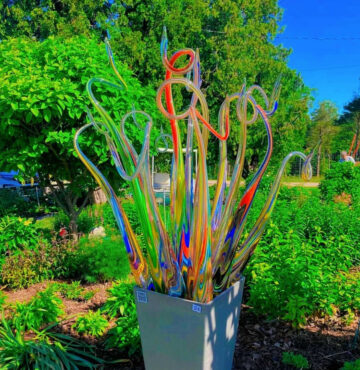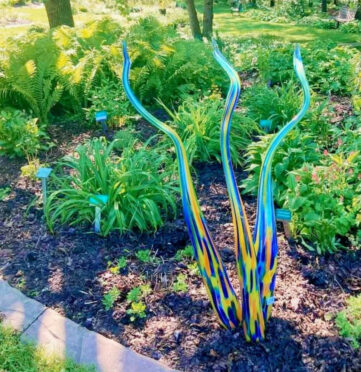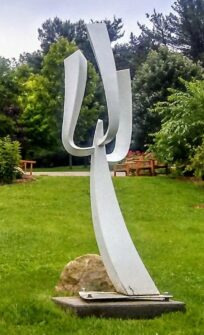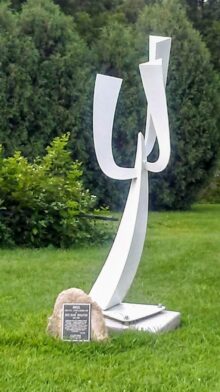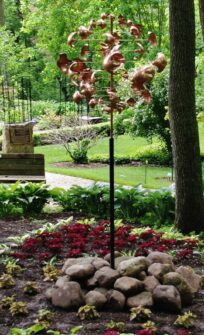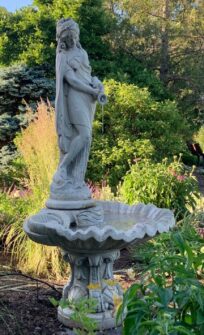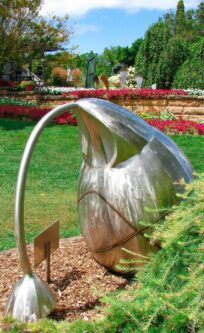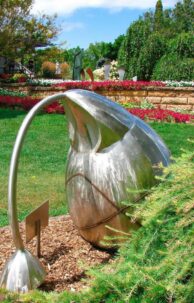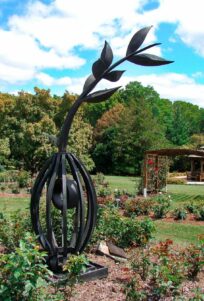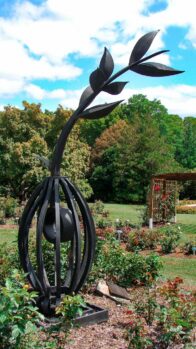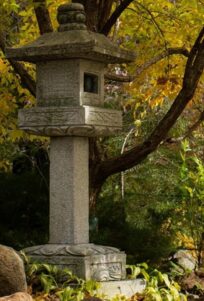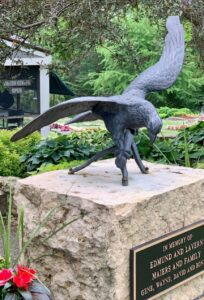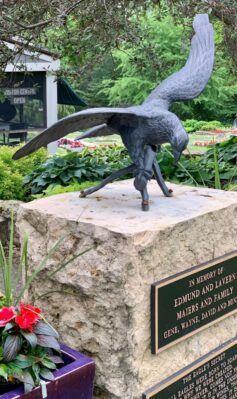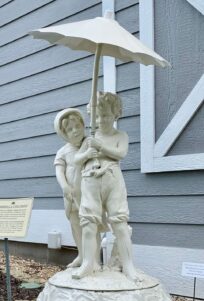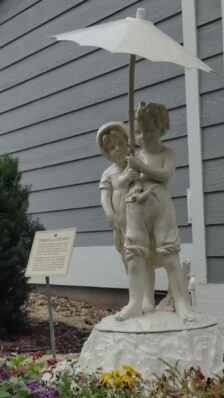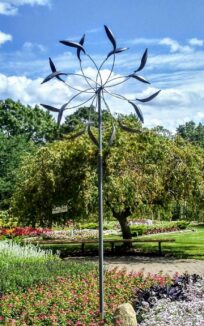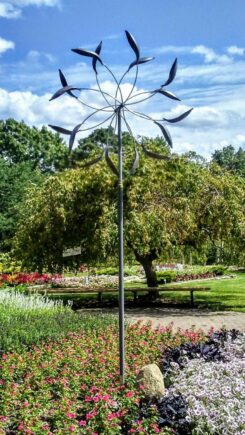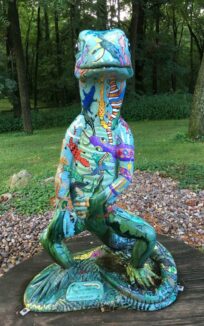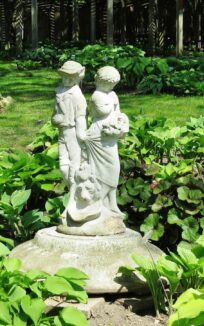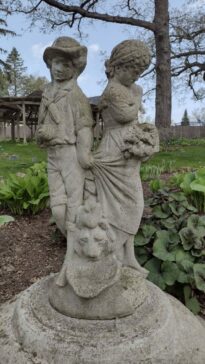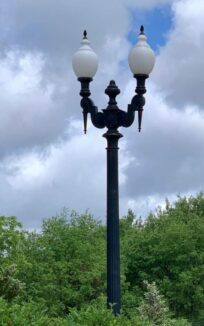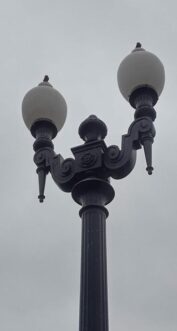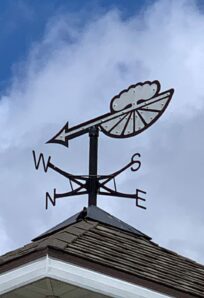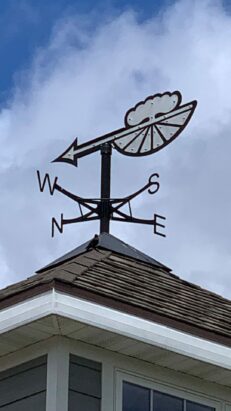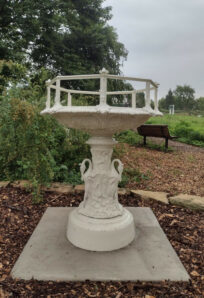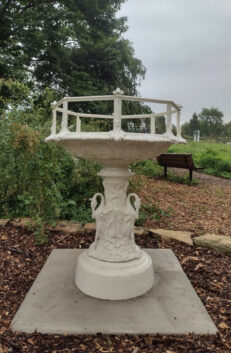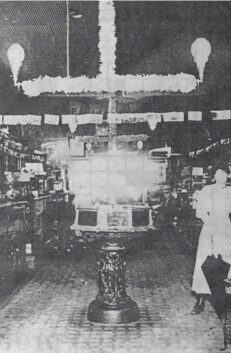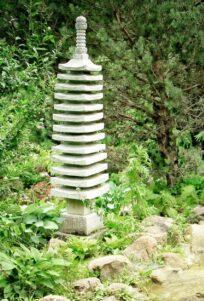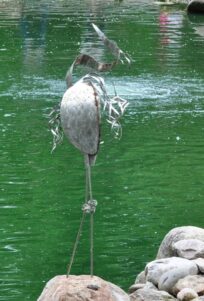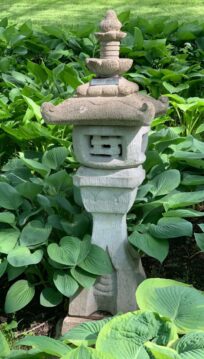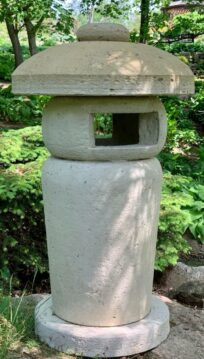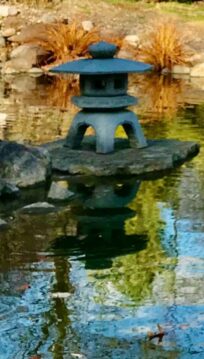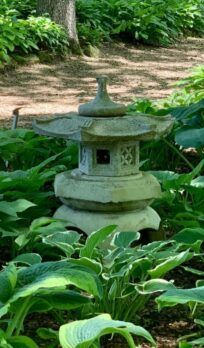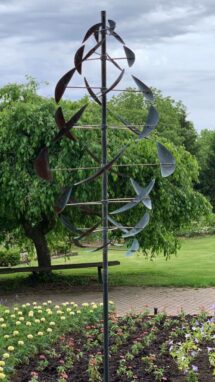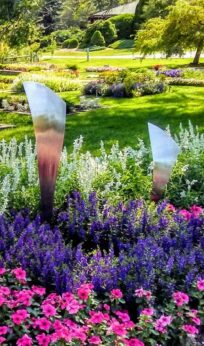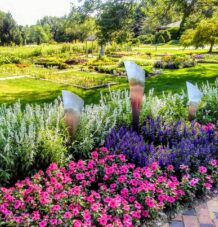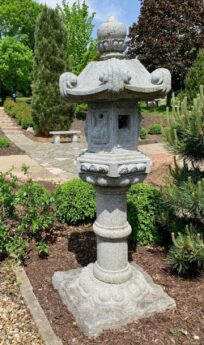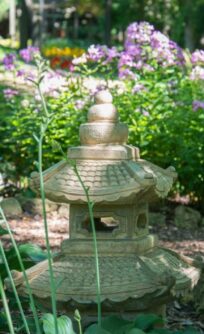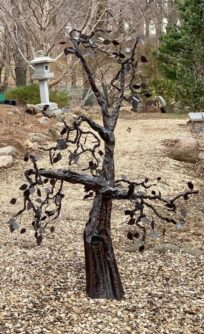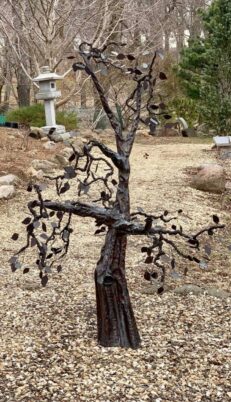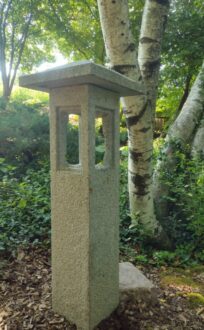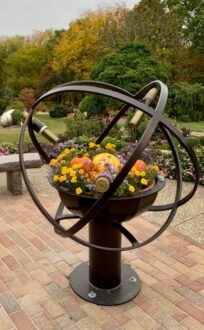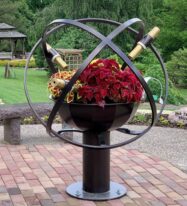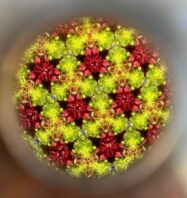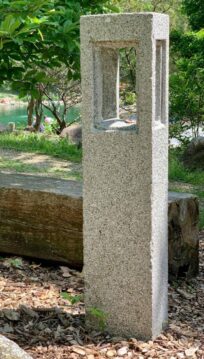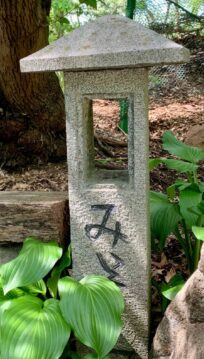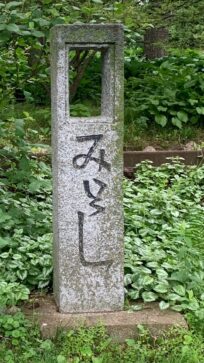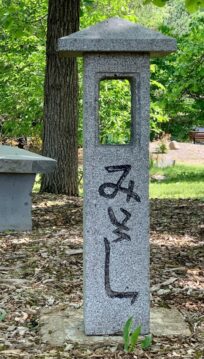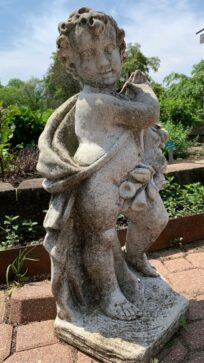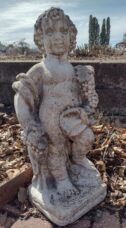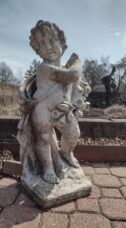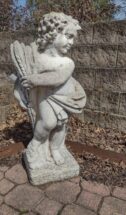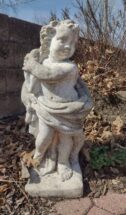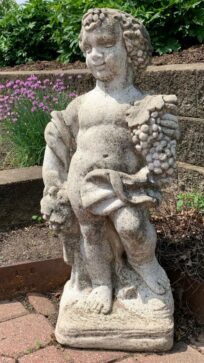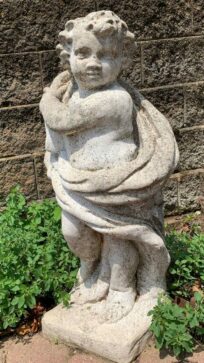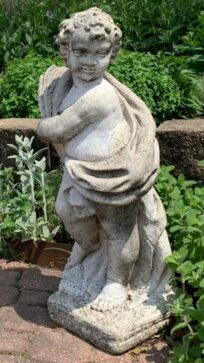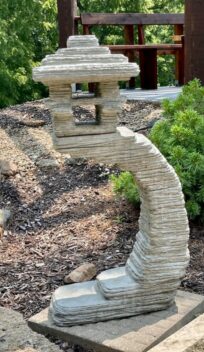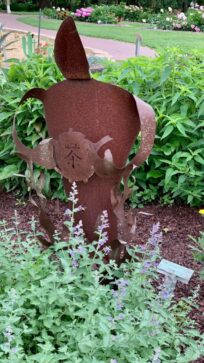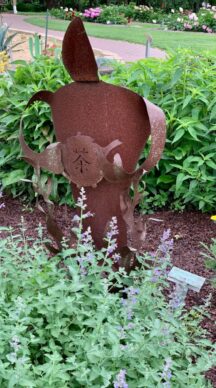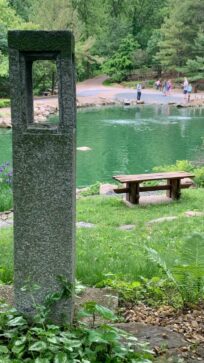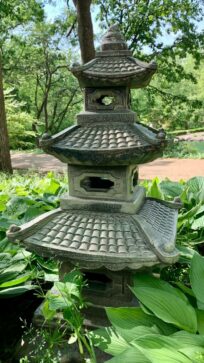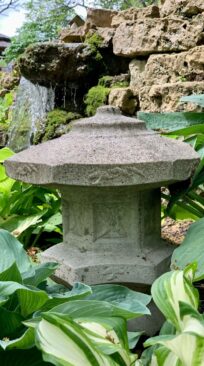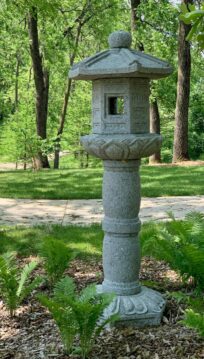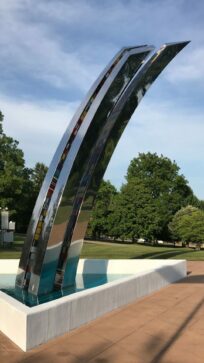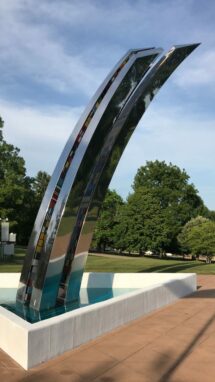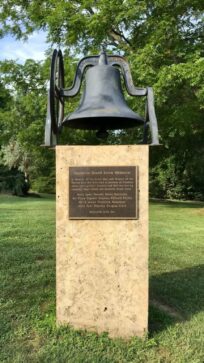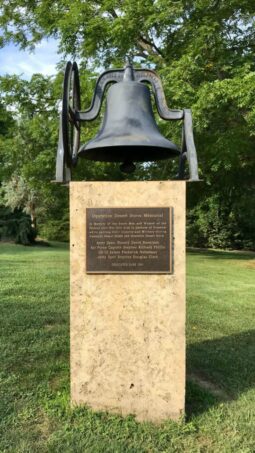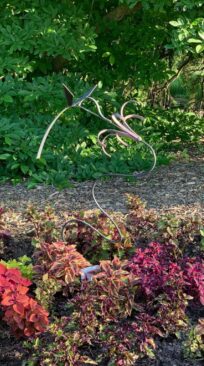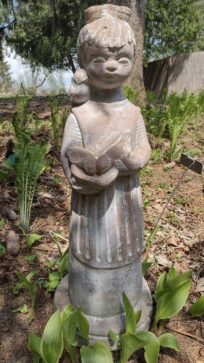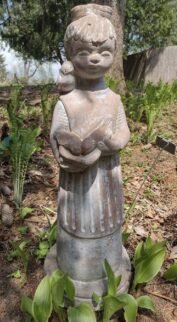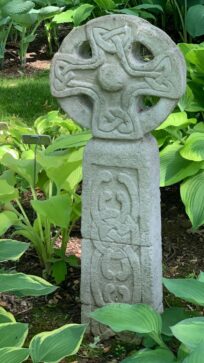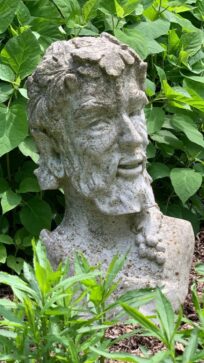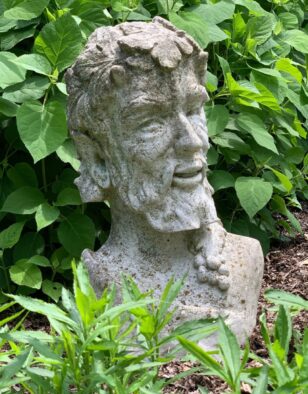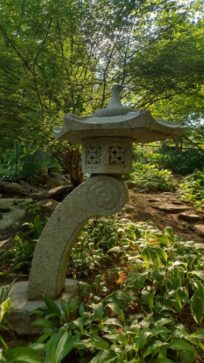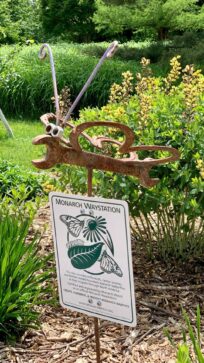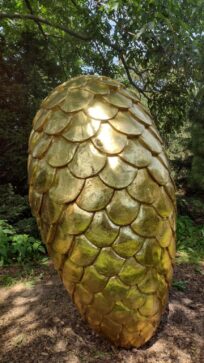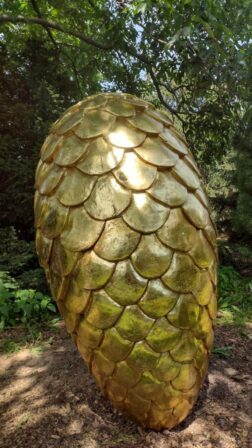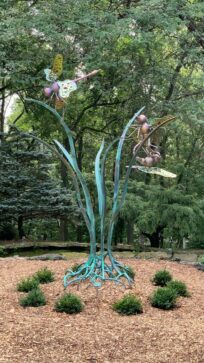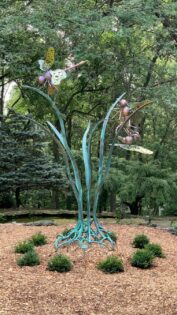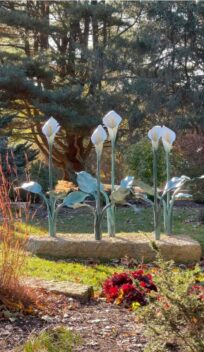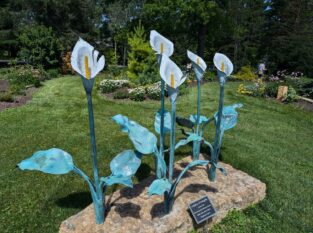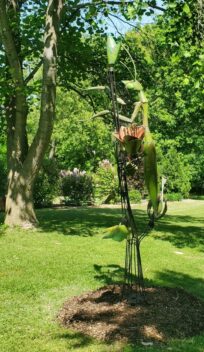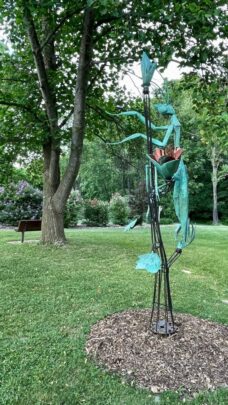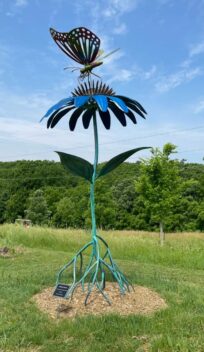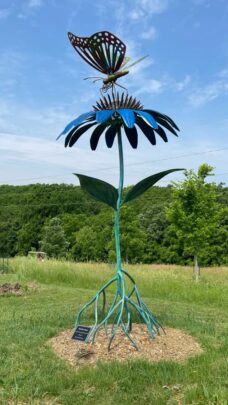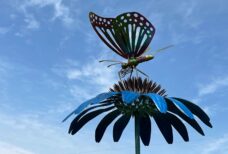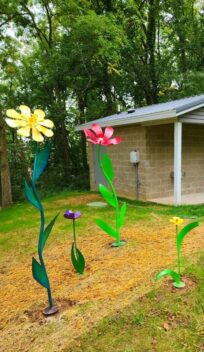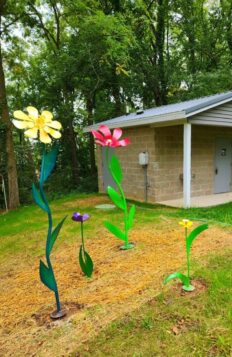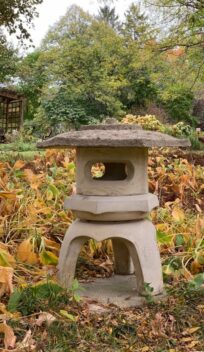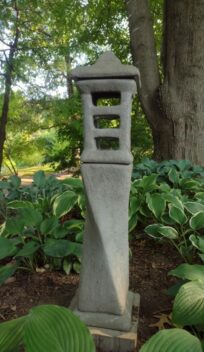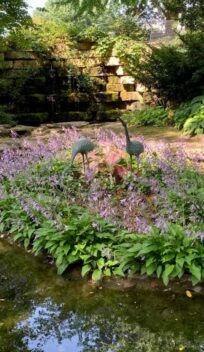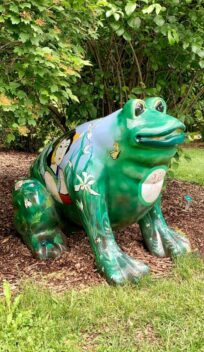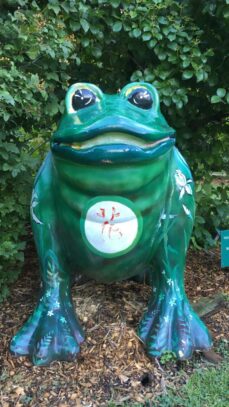The Art in the Gardens
2024 Blown Glass Art Exhibit
Generously sponsored by

Thanks to Joel Ryser, Executive Director and Founder of Hot Glass Inc., 37 stunningly unique blown glass pieces are installed on the DABG grounds as an exhibit through October.
All pieces are available for purchase. Please visit the Hot Glass website (click the logo below) for more information and pricing.

About Hot Glass
Hot Glass is a hands-on, non-profit organization dedicated to the instruction, presentation, interpretation, collection, documentation and preservation of the contemporary glass art movement with a special focus on team building for organizations.
Permanent Art on Display on the DABG Grounds
[Click on any art piece to learn more or to view a larger image.]
ANGEL
Artist: Eric Shaw (1965-1996)
Material: Plate Steel, Curved, Welded
Eric Shaw: "Inspiration for my art is primarily derived from nature … In many of my works, I take elements of plant and animal life, human forms or ancient structures and combine them to create unique forms that are a synthesis, like a double exposure. … I strive to celebrate the rich heritage of life and the structural beauty of the parts of our earth.”
A gift of Eric's Parents, Blossom and Jay Shaw, Iowa City, Iowa. 2017.
Location: near the Garden of Eat'n
MIGRATION
Artist: Dave Riemer
Material: Polished copper
This mesmerizing kinetic sculpture uses the slightest breeze to move its graceful sweeping arms, changing with the light as they cast complex geometric shadows. Watching their motion has been described to be ‘as relaxing as watching a lazy river.’ If you look very closely, you will see that the inside and the outside rotate in opposite directions. The sculpture was shaped and assembled by hand, using the highest quality bearings, copper, brass, and stainless steel.
Gift of the Neuwoehner family in honor of their parents Robert and Marion Neuwoehner 2014
Location: Knot Garden
THE SEEDLING
Artist: Stephanie Sailor / Lawrence, KS
Material: Stainless Steel
"The Seedling" represents the first phase of life for a plant, once it has trudged through the earth to feed off sunshine rays. The stem is thin and tenuous, originally unable to support the weight of the future foliage. This is the moment marked by unbounded possibilities, quite similar to ourselves as we start new stages in life.
A gift of Bob & Donna Wahlert. 2007.
Location: near McKay Plaza / Berm S. 17
GERMINATION
Artist: Glenn Williams
2008 / Displayed with Art on the River
Germination means to sprout or grow. It is the process of coming into existence. the piece is intended to serve as a metaphor for this growth as it relates to the human condition. Those plants that have to struggle for life in the beginning tend to become more resilient as a result of that struggle. In essence, what doesn’t destroy us, makes us stronger.
A gift of the Tri-State Garden Club in conjunction with an arts grant from the City of Dubuque. [This sculpture honors the efforts of the Tri-State Garden Club in establishing and maintaining this rose garden.]
Location: Rose Garden
UNION PARK SCULPTURE
In the early 1900s, Union Park, a north-end Dubuque park regularly drew hundreds of visitors. Located on the other side of our deer fence, it was "the place" for entertainment until July 9, 1919. That day a sudden rainstorm caused a flash flood that tore through the valley, damaging the park’s structures and killing five people.
This sculpture (two children with umbrella) survived the tragedy.
Location: near the Visitor Center
THE LIZARD
Lizards painted by Burkart Studio (local artists)
The lizard was originally part of a National Mississippi River Museum promotion for the “Lizards on the Loose” exhibit in 2009.
There are multiple lizard friends hiding on this lizard.
The types of lizards painted on it are explained on sheets printed behind the statue itself; the local artists who painted the lizard are named on the back of its base.
Purchased for the Dubuque Arboretum using donated funds.
Location: near Gottschalk berm
PARKING LOT LIGHTS
In the late 1800s and early 1900s, downtown Dubuque had gas-operated lighting. The lamplighter walked from light to light in the early evening and then extinguished the lights the next morning.
In 1916, the gas lights were changed to electric. With urban renewal, the city took the lamps out and offered them to nonprofit organizations. The Dubuque Arboretum and Botanical Gardens acquired three of these lights. Jackson Tuckpointing sandblasted them, and Paulson Electric rewired them. [If you look closely, you can see the fine machining on them.]
They are genuine antiques, and yet they keep our parking lot illuminated.
Location: near the Visitor Center
ARBORETUM-BRANDED WEATHERVANE
Artist: Rob Trilk | 19th BLVD Metalsmithing
Material: Powder-coated 18-gauge steel
When Rob Trilk was asked to come up with a design that included the DABG’s logo in a weathervane, he rose to the challenge.
He machined on a metal lathe the pivot point housing and a sealed ball bearing was pressed into it so the weathervane would turn with the wind, allowing it to operate friction-free.
Rob Trilk: “(My wife) Carissa and I now feel a warm connection to the Arboretum because of it.”
A gift of Rob Trilk, in memory of his wife’s mother, Diane Stamp. 2017.
Location: atop the Visitor Center
Ragatz Drug Store Fountain
Created: circa 1890s
Material: cast iron
The cast iron fountain was originally a feature in the Ragatz Drug Store at 1996 Central Avenue in Dubuque (where a KFC is presently located) from 1899 to the mid-1960s when the store closed. Swimming in the fountain were goldfish that customers were able to purchase.
Several years after closing, the area was cleared for an urban renewal project. When the building that had housed the drug store was torn down, Louise Strub, a great-niece of George Ragatz, wanted the fountain for her back yard where, for many decades, the Strub family used it as a large planter. [The fountain-planter stands about 4 feet high.]
A gift of the Strub Family.
Location: Corner of the Prairie Garden, on the way down to the Japanese Garden.
EARTH KITES
Artist: Eric Shaw (1965-1996)
Material: Plate Steel, Curved / 1990
Eric Shaw: “Inspiration for my art is primarily derived from nature … In many of my works, I take elements of plant and animal life, human forms or ancient structures and combine them to create unique forms that are a synthesis, like a double exposure. … I strive to celebrate the rich heritage of life and the structural beauty of the parts of our earth.”
A gift of Jay Shaw (Iowa City, IA), in memory of Blossom Shaw. July 2019.
Location: Peony Bed (currently) / set of 5 / can be moved to different locations
ANCIENT PROTOCOL
Artist: Paul Russell | Brookfield, IL
Material: Steel
Dimensions: 9’ W x 12’ H x 8’ D / 1,200 lbs.
Ancient Protocol celebrates creation and perseverance of life. Giant dragonflies perch on giant tall grass. The dragonflies are made of an assortment of steel grades. The dragonflies are plated using zinc-nickel chromate. The grass has a brass/copper/bronze impregnated paint coating applied with a patina. High quality clear auto paint is the top coat. The artist created this work using the skills of a blacksmith inherited from his great grandfather who came from England in 1907 and set up shop shoeing horses and then moving on to creating tools and hardware. Today the artist teaches sculpture classes at the School of the Art Institute of Chicago using these methods.
A gift of the Ken and Edna Mozena Family
Location: Gottschalk Falls
LEGACY OF INTEGRITY
Artist: Paul Russell | Brookfield, IL
Material: Angle iron (lilies); limestone (base)
The name of the sculpture, Legacy of Integrity, was chosen for two reasons:
- We all create our own legacy and integrity as a result of influences and circumstances in our lives. We then inherently pass down our practiced values and intellectual integrity through generations.
- Another component is the physical aspect: while the calla lilies appear to have physical integrity, the steel and its stone base will corrode over time, compromising integrity.
The calla lilies embedded in this 3,000-lb. block of limestone were forged from bars of angle iron. A spreader tool was used to move the steel outward to create enough area for forming the flowers and leaves. The steel had to be heated between 1700-2100 degrees for persuasion.
A gift of the Ken and Edna Mozena Family in memory of Jeff Mozena’s mother (Edna). Calla lilies were her wedding flowers. 2022.
Location: Mozena Conifer Collection
REACHING
Artist: Jeremy Rudd | Petersburg, IA
Material: Enameled Steel and Copper
The literal form of the mantis reaches out from its perch towards the existing tulip tree ... reaching for a new destination or reconnection to an old. The blossoms on the branch represent the cyclical nature of life from bud to blossom to husk with the mantis reaching up to new life leaving the husk below. There are two main components:
- Branch, blossoms, petals. The branch is welded steel mimicking the structure of the tulip tree. The blossoms are constructed from copper sheet and tubing. The petal forms are hammered copper.
- The mantis body. This component is completely constructed with copper. The exterior body parts were shaped over wooden forms created for the piece. The shaped panels were then fit together with copper rivets and soldered onto an internal structure.
A patina was applied to all copper elements giving the piece its distinct green color.
A gift in memory of Dr. Allen D. Harves from his daughters Heather and Erin Harves.
Location: Between Legacy Tree Trail and the Hydrangea Garden on the right-hand side of the roadway.
BUTTERFLY'S DINNER
Artist: Paul Russell | Chicago, IL
Material: An assortment of solid steel bars + pipes + plates
As we consider a butterfly's dinner (a coneflower), we realize the importance of our natural world: the sculpture is a macroscopic depiction of tiny flowers growing off many seeds rich in nectar and pollen.
Construction details:
- 150 "seeds" were forged using dies for forging grapnel tines.
- The "cone" was formed from a perforated sheet of steel.
- The butterfly is hollow and welded water-tight to prevent acid from the plating process to get inside, which could ruin the iridescent zinc-nickel plating.
ARTIST'S NOTE: The butterfly's "tongue" is coiled up and currently not feeding on the flower. Butterflies have a straw-like proboscis -- with two "canals" (similar in structure to a coffee stir stick) they use for drinking nectar from flowers. When not in use, it coils up into a tight spiral. I thought a coiled-up proboscis would be more aesthetically pleasing than a stretched-straight-with-a-slight-elbow-bend one leaning down to the flower.
A gift of the Ken and Edna Mozena Family in memory of Kris Ann Mozena.
Location: Legacy Tree Trail by the fence near the NW Arterial.
WELCOMING FLOWERS
Artist: Stephen Kishel | Bluffton, SC
Material: Welded metal
From the artist:
- Passionate Purple. Flowers are good for mental and physical health. Perhaps we all should have gardens because they teach us delayed gratification, patience, and help us appreciate nature's natural beauty.
- Full Sun. This yellow flower likes full sun but brings smiles -- rain or shine, summer or winter.
- Full Bloom. This tall flower is in full bloom and is like a welcoming Sign of Spring.
- Tall Yellow Bloomer. Be bold. Stand tall. Always look forward. Be engaged in the present, for the past is gone, and the present is yours for the asking.
A gift of Paul and Roberta Gaines, Bluffton, SC, in honor of Roberta's mother, lifelong Dubuquer Eileen Hillis Klawitter, who loved spending time at the DABG.
Location: Legacy Tree Trailhead.
THE GIANT FROG
Painted by local artist: Terry Mozena
The Giant Frog statue was part of the 2005 “Toadally Frogs” exhibit and promotion at the National Mississippi River Museum in Dubuque.
The Japanese letter on the front of the frog means “flowers.”
An anonymous donor purchased the frog for the Dubuque Arboretum. 2005.
Location: near the Children's Garden




